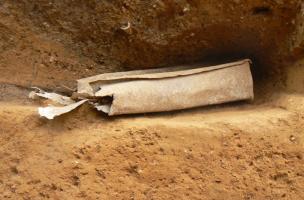Search
You are here
Purple and lead
A team from the Inrap recently excavated part of the cemetery of Gallo-Roman Evreux Mediolanum Aulercorum. One hundred and thirty four burials dated to the 3rd century AD were found between October 2006 and June 2007. In addition, the excavation has given archaeologists the opportunity to study a funerary practice previously unknown in Roman Gaul.
Chronicle of site
Post date
28 January 2008
Last modified
26 January 2017
Numerous adults were buried in atypical positions, several of them on lying on their stomach. The second exceptional element of this cemetery is the deposit of portions of horses in most of the burials, most often skulls or vertebrae. The most remarkable burial is that of an adult with its head encircled by two horse skulls.
The archaeologists propose the hypothesis of two different populations, skilled knackers and a group of paupers.
The archaeologists propose the hypothesis of two different populations, skilled knackers and a group of paupers.
A fortuitous discovery
Once the excavations were over, the construction of a house was begun. Beyond the excavation zone, within a trench section, a lead coffin was visible. The regional archaeology service intervened and asked the Inrap archaeologists to remove the coffin for conservation purposes.
A rich Gallo-Roman woman
Half of the coffin was destroyed by earthmoving equipment, which explains the nearly total absence of the skull, trunk and upper limbs of the deceased. The intact parts are in an excellent state of conservation (coffin, skeleton and objects).
The outside of the coffin was made from a leaf of lead folded back onto itself. In the bottom, under the pelvis, an opening was made to allow evacuation of the decomposition fluids of the cadaver of an adult female (30-40 years old).
Though not exceptional, Gallo-Roman lead sarcophagi were reserved for an elite group. The burial of this rich woman appears intrusive among those of the groups of paupers and knackers. The grave goods deposited inside the sarcophagus confirm this richness. In addition to coins, the body was enveloped in different tissues and fur. Most surprisingly, purple cloth, coloured with the secretions of the marine gastropod Murex trunculus, was spread around the interior of the coffin during the funeral ceremony. Samples of this substance will be analyzed to determine its exact composition. Other analyses of organic anhydrous residues and of insects which eat dead flesh are currently in progress.
The outside of the coffin was made from a leaf of lead folded back onto itself. In the bottom, under the pelvis, an opening was made to allow evacuation of the decomposition fluids of the cadaver of an adult female (30-40 years old).
Though not exceptional, Gallo-Roman lead sarcophagi were reserved for an elite group. The burial of this rich woman appears intrusive among those of the groups of paupers and knackers. The grave goods deposited inside the sarcophagus confirm this richness. In addition to coins, the body was enveloped in different tissues and fur. Most surprisingly, purple cloth, coloured with the secretions of the marine gastropod Murex trunculus, was spread around the interior of the coffin during the funeral ceremony. Samples of this substance will be analyzed to determine its exact composition. Other analyses of organic anhydrous residues and of insects which eat dead flesh are currently in progress.

Sarcophage en plomb. Nécropole d'Evreux.
© Antoine Cottard, Inrap

Pieds de la défunte. Sarcophage en plomb. Nécropole d'Evreux.
© Antoine Cottard, Inrap
Developer : Private
Curation : Regional Archaeology Service (Drac Haute Normandie)
Site director : Sylvie Pluton, Inrap
Contact(s) :
Mahaut Tyrrell
Media communication
Inrap, media partnerships and relations department
+33 (0)1 40 08 80 24
mahaut.tyrrell [at] inrap.fr

